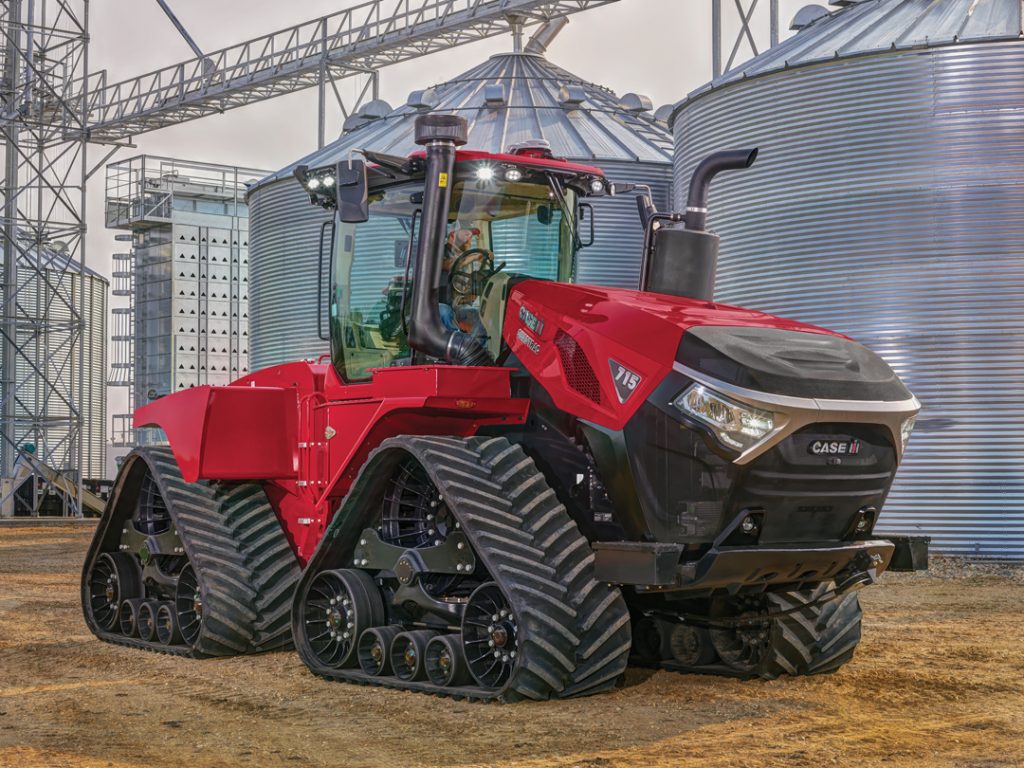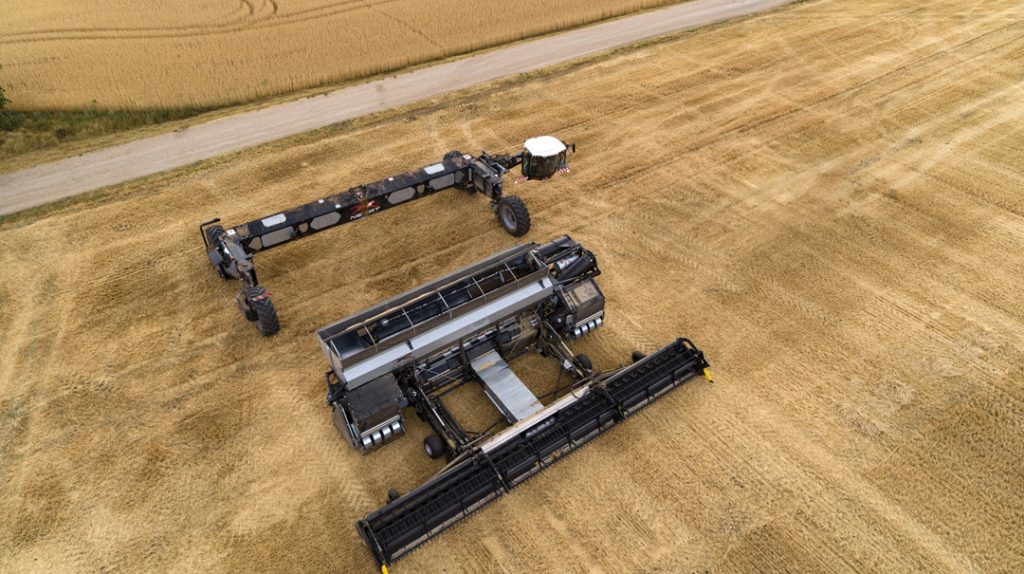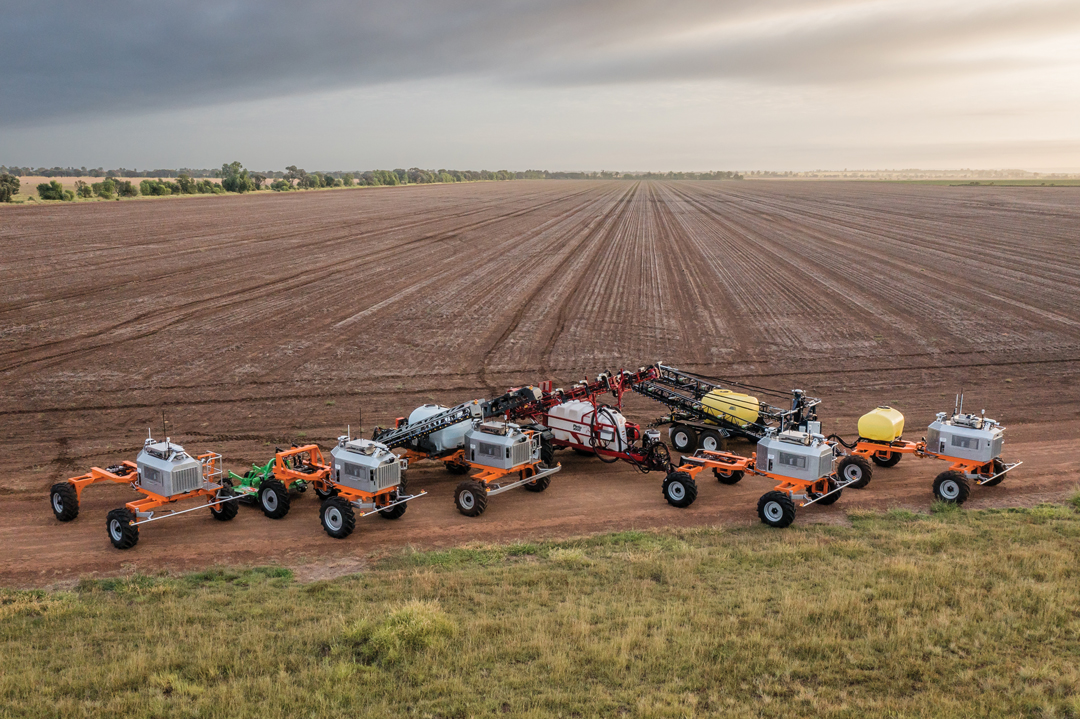NEW DIRECTIONS IN TRACTOR TECH
BY KAITLIN PACKER BERGER • LEAD PHOTO COURTESY OF SWARMFARM
As farms continue to increase in size, certain equipment manufacturers race to provide high-horsepower machinery that can stretch a farmer’s reach when they seed, spray and harvest. Farmers also require these increasingly efficient options to contend with a shrinking agricultural labour pool. With their own solutions to field work dilemmas, further equipment makers have developed autonomous vehicles that can work 24/7.
Efficient use of time at critical stages in the season is a key consideration for many farmers when they make a purchase decision for new machinery. If they can use a more powerful tractor to pull a seeder that’s 10 to 12 feet wider than their current setup, the benefit may outweigh the cost of the equipment. “It’s getting that crop off faster, at a quicker rate,” said John Schmeiser, president of the North American Equipment Dealers Association. “We’re always challenged with weather both in the spring and in the fall.”
Advancements made in precision agriculture have increased the efficiency of larger implements when pulled behind highhorsepower tractors. Without even touching the wheel of the tractor, farmers can trust GPS systems to ensure there’s no overlap of seed, fertilizer or chemical inputs. “All of those things are kind of taken into consideration,” said Schmeiser. “I still understand why there’s a customer base out there, looking for higher horsepower at the top end because they can pencil it out about what more they can do in one pass.”
While there are some options on the market on a smaller scale, Schmeiser said he expects the industry has a long way to go before we see electric versions of the largest tractors on the market today. “If you have a 600-horsepower diesel engine that’s pulling a 60-foot air drill, will you ever get to the stage where you have enough battery power to operate the hydraulics?”
Autonomous tractors are a different story. “I’m very impressed with what the manufacturers have done to this point in autonomy and autonomous vehicles,” said Schmeiser. With a decade of industry research and development behind them, all that’s left to get them in the field is to work out liability concerns.

As of March 2024, John Deere began to accept orders for its 9RX 710, 770 and 830 tractors with expected delivery starting in Canada by November. Although it has an existing 9RX lineup, these three new models are entirely redesigned, said Michael Porter, the company’s go-to-market manager for large tractors.
Key features for these models include the new e21 transmission and the JD18 engine, which is higher powered
than the previous JD14X engine on the 9RX 640. The transmission is configured to allow the operator to skip shifts and increase speed more quickly than with smaller 9RX models. “It’s going to just be able to physically move that heavier weight faster,” said Porter.
All this muscle is essential because the new machines now weigh up to 74,000 pounds, around 12,000 pounds more than smaller 9RX models—and they could weigh as much as 84,000 pounds with ballast. The machines are equipped with a 30- or 36-inch-wide track option with an additional midroller to help more broadly distribute the extra weight and reduce compaction.
One claim to fame for the new 9RX tractors is farmers can disk 100 more acres per day than with previous models. They can attach a high-speed disk or add a few extra feet to the width of the implement to cover more ground in less time. “If you have a big freeze coming, with tillage, that’s really important,” said Porter.
The new 9RX tractors can also carry twice the cart load on hills and travel 1.6 km/h faster than their predecessor.
“Previously, some customers would have to only put half of the load in their air cart in order to be able to climb those hills with all that weight,” said Porter. An updated hydraulic system with dedicated pumps for both machine functions and the implement also contribute to their hill climb ability. “A lot of times that flow is prioritized to the machine and so lifting that implement can be really slow or the fans can start to slow down,” said Porter. The new machine with its dedicated pump allows these systems to work independently.
These models are ready for the future, meeting the Final Tier 4/Stage V emission standards with no diesel exhaust fluid—a convenient feature that will save farmers time in daily maintenance. They’re also one add-on away from being autonomous. “If a customer decides in a year or two from now that they want to run autonomously, all they need to add is the camera perception system,” said Porter.
John Deere’s Electric Variable Transmission (EVT) is geared to customers who want the easy driving and quick acceleration of the company’s Infinitely Variable Transmission (IVT)—available in 7R and 8R tractors—in a high horsepower tractor. “It does all that hard work for you. It uses electric motors to drive the transmission and generate electricity for offboard applications.
“We’re really looking forward to seeing where this offboard power goes and how we can solve some of these customer pain points with this technology,” said Porter. “There’s a lot more to come in the EVT space in the future.”

Case IH introduced the new Steiger 715 Quadtrac to the Canadian market this year, a significant jump from its Steiger 645 with a 13-litre engine. The new model has a 16-litre engine and features a larger drive wheel and a track that’s about a foot longer than the previous generation. “By having a longer track, that also got us an increased travel speed of 26.5 mp/h [42.6 km/h], so about 2.5 mp/h [4.0 km/h] faster than what we were doing before,” said Morgen Dietrich, tractor segment lead for Case IH.
A heavy-duty suspension (HDS) track will be available for the 715 Quadtrac and additional Quadtrac models in 2025. “And what a HDS does is it builds on that larger drive wheel, but we added suspension, so now this is an active suspension system, active hydrauliccylinders that are allowing this track to now mold and adapt to all the soil’s imperfections,” said Dietrich. The robust suspension also reduces vibration of the operator seat by 40 per cent.
Central Minnesota farmer Frans Rosenquist owns a 715 Quadtrac and likes the new model’s increased cab comfort. “I call it an old man’s tractor, because it rides so smooth in the cab that it’s just like you’re driving on air,” he said. With its increased seat swivel, Rosenquist doesn’t have to crane his neck to look behind the vehicle.
He farms approximately 6,000 acres with his son and son-in-law and grows corn, soybeans and vegetables. With 50 hours pulling a 60.5-foot cultivator behind his new high-horsepower tractor, Rosenquist said it effectively does the job of two of his older tractors because he can pull equipment and travel much faster. “This is the highest horsepower tractor we’ve ever had.” On this machine, acres with steep hills are not as challenging as they once were, he said. “I did shift down two gears from what I normally go because the hills were so steep, but it just walked right up them,” he said. “It’s also got better fuel economy than our 620s have, and that’s one of the things I really liked about it, is the fuel economy; and the horsepower is just unbelievable.” He also likes its larger fuel tank, which reduces the number of refills required.
As farms get larger, Rosenquist sees such machines as the way of the future. All the farmers he knows are trying to find ways to get more acres done in a day. The key, he said, is to find a tractor that provides the power and is enjoyable to ride.

Canada’s first NEXAT widespan controlled traffic system, an autonomous carrier vehicle with interchangeable implements, will be employed as a harvester in Manitoba this fall. NEXAT GmbH was founded in 2017 by Felix and Klemens Kalverkamp. The German company’s machine employs two 550-horsepower diesel engines that power four small electric engines at each wheel. The 45-foot carrier accommodates compatible implements produced by partner manufacturers. It’s a 10-minute task to swap out these interchangeable units or to switch from field to street mode. These tasks can be completed from inside the unit’s cab or by remote control.
NEXAT does market its own harvester implement for large and small grains with a 50-foot header and approximately 900-bushel grain tank that can unload about 17 bushels per second. “We tripled the unloading capacity of common harvesters,” said Hannah Ovelhey, NEXAT agronomist.
The system’s single-wheel drive travels on permanent tramlines that limit compaction. “You’re basically using every tramline twice as compared to normal controlled traffic farming, and thus reducing the traffic share of your fields, so we can eliminate compaction from up to 95 per cent of your field,” said Ovelhey. The solidness of the compacted soil in the tramlines allows it to be trafficked earlier in the season, which gives farmers a head start on field work.
Ovelhey’s goal is to continue to improve NEXAT’s contribution to regenerative agriculture. “Not compacting your soil anymore gives a lot of opportunities for reducing tillage and reducing soil disturbance in general, improving your soil life, health and fertility,” she said. The company is at work on improvements to the system’s autonomous capabilities and in the early research and development of a hydrogen fuel cell replacement for its diesel engines. “Our vision at NEXAT is that we want to make climate-neutral agriculture possible,” said Ovelhey.
An Australian company has taken yet another approach to improve field work efficiency. In a move away from highhorsepower machines, SwarmFarm offers lightweight, 86-horsepower, autonomous robots that can operate 24/7. “There’s really big adoption of our own robots here in Australia now,” said Andrew Bate, CEO of SwarmFarm. These units now work more than four million acres. North American adoption has just begun, with one machine being employed in the United States and a trial run that was conducted on a Saskatchewan farm late last year. Bate founded the company with his wife Jocie, the company’s CFO. “The reason we started SwarmFarm robotics was not to save labour, it was actually to be better farmers,” said Bate.
The couple grow wheat, barley, chickpea, mung bean and sorghum on 11,000 acres and maintain a herd of 800 cattle. When they launched the company, they managed 20,000 acres. “What we found was, as we got bigger, we weren’t as good of farmers as we used to be,” he said. “We found that machines were so big and so heavy, they were causing super compaction.”
The use of large tires or tracks may reduce compaction on the top four inches of soil, but they cause deeper, long-term compaction. SwarmFarm units feature a lightweight base and light axles to reduce soil damage. “The only way to truly prevent deep soil compaction is to reduce your axle weights,” said Bate. Docking stations allow the autonomous units to refill their small fuel and spray tanks up to 15 times a day.
Like NEXAT, SwarmFarm partners with additional companies that provide compatible implements. These are sprayers for now, but fertilizer and seeding equipment is in development. With its own onboard weather station, each robot reacts to the environment on the go and will stop and start as conditions dictate. Because the system is autonomous, farmers pair it with spot spray technology and the unit completes multiple field passes. “They go and spray it again, and they spray it again, and they spray it again, and they’re only using a miniscule amount of product,” said Bate. This can reduce weed pressure to where Bate has seen farmers sow crops they previously could not have.
Whether it’s higher horsepower or autonomous equipment big and small, the shared goal among farmers and manufacturers is to increase efficiency and sustainability. “The sophistication and the technology that’s in agriculture right now is just really off the charts; it’s phenomenal,” said Schmeiser. “This is one of the best kept secrets about agriculture, about how sophisticated it is.”







Comments